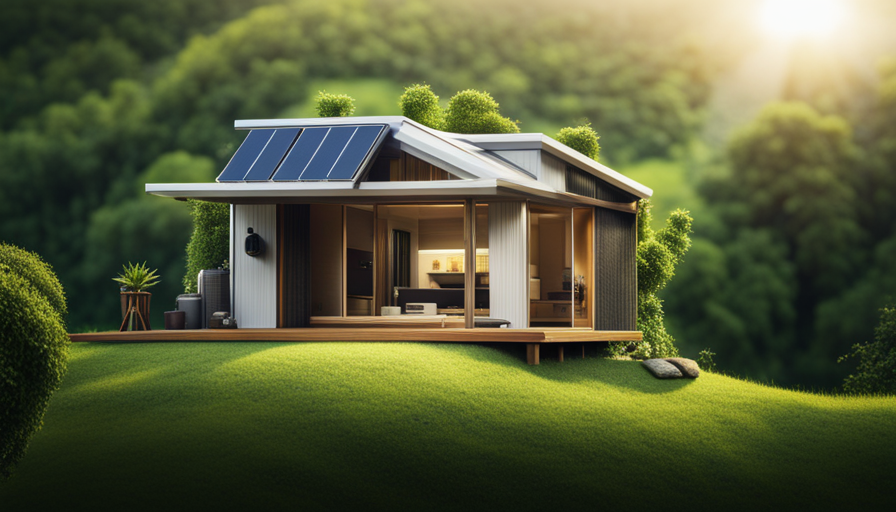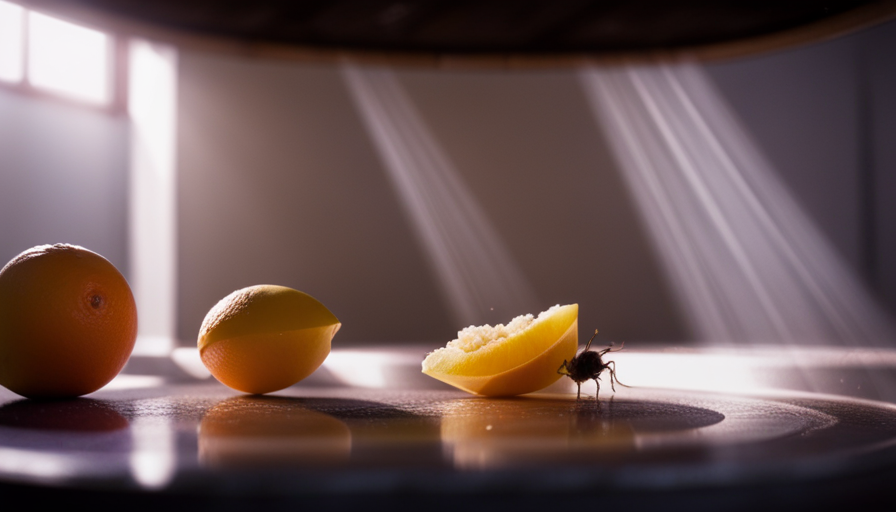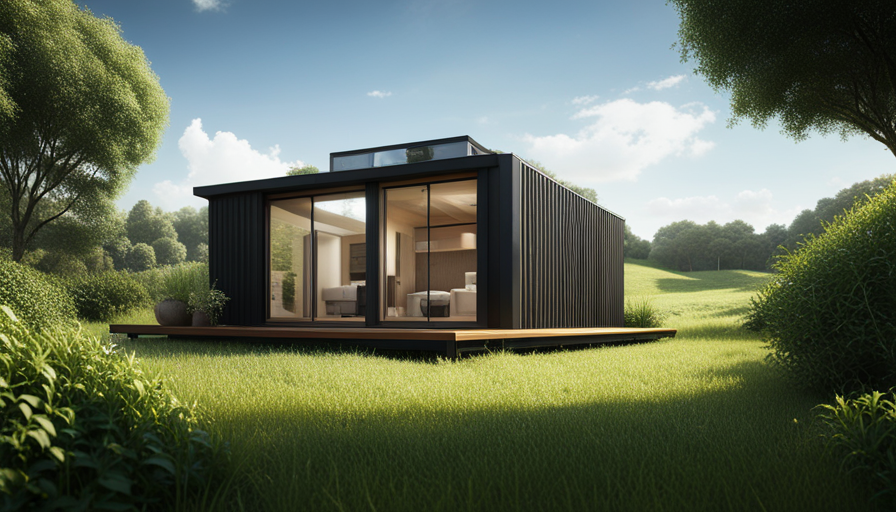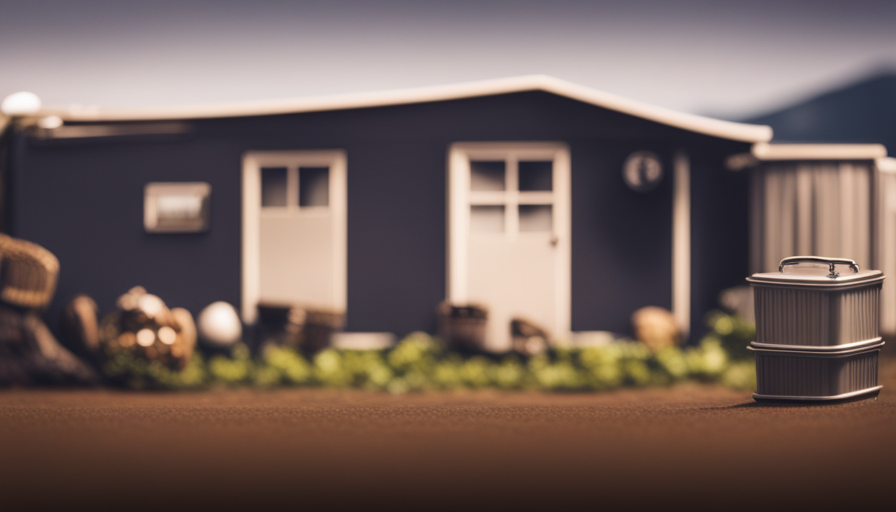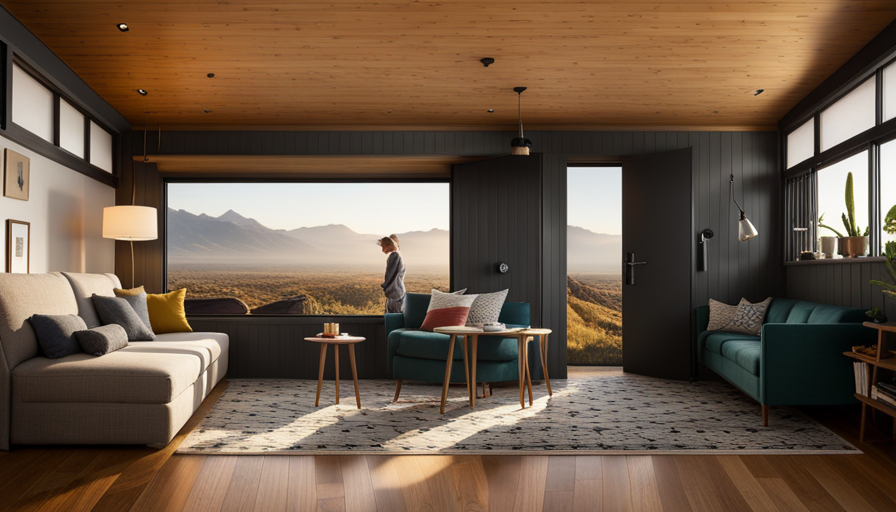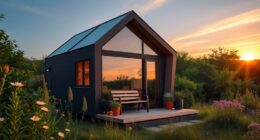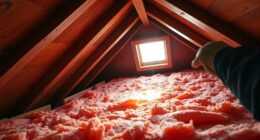Powering a small house with **solar panels** involves various steps. You need to determine your energy requirements, select the appropriate panels, and maximize energy efficiency. There are key factors to think about when setting up a solar system for a tiny house. Interested in learning more about how to efficiently power a tiny house with solar energy?
As a technical expert in the field, I have analyzed the process and can guide you through the steps to determine how many solar panels you need for your tiny house.
First and foremost, it is crucial to assess your energy needs accurately. By taking into account your daily power consumption, you can determine the wattage required to meet those needs. Additionally, considering your location and climate will help you understand the amount of sunlight you can expect and how it will affect your solar panel performance.
Choosing the right solar panels is another critical aspect. Different panels have varying efficiencies and wattage outputs, so it is essential to select ones that align with your energy requirements. By calculating the wattage of each panel and determining the battery storage capacity, you can ensure a reliable power supply in your tiny house.
To optimize energy usage, it is crucial to monitor and maintain your solar system regularly. Seeking professional guidance and considering future expansion can also help you make informed decisions. With these steps in mind, you can design a solar system that efficiently powers your tiny house and reduces your carbon footprint.
Key Takeaways
- Accurately assess energy needs and power consumption in order to determine the number and type of solar panels required for a tiny house.
- Consider location and climate to optimize solar panel performance and efficiency.
- Choose the right solar panels with varying efficiencies and wattage outputs based on the specific energy requirements of the tiny house.
- Seek professional guidance for designing and installing a solar system, considering factors like future expansion, battery storage, and energy management for long-term sustainability.
Assess Your Energy Needs
You’ll need to assess how much energy you’ll need to power your tiny house. This can be done through an energy audit, which involves evaluating your power consumption.
Start by making a list of all the appliances and devices you plan to use in your tiny house. Determine their power requirements and estimate the average number of hours you’ll use them each day. Add up the total power consumption to get an idea of how much energy you’ll need.
Consider factors such as lighting, heating or cooling systems, electronics, and kitchen appliances. Once you have a clear understanding of your energy needs, you can move on to the next step and consider your location and climate. This will help determine the size and number of solar panels you’ll need to power your tiny house efficiently.
Consider Your Location and Climate
Living in different locations and climates, you might need to take into account the amount of sunlight available and the weather conditions in order to determine the suitable number of solar panels for your compact dwelling.
Energy efficiency tips can help maximize the performance of your solar panels. By insulating your tiny house properly and using energy-efficient appliances, you can reduce your overall energy consumption, allowing a smaller number of solar panels to meet your needs.
Solar panel placement is also crucial. Installing them in an area with maximum sunlight exposure, free from obstructions such as trees or tall buildings, will ensure optimal energy generation.
Additionally, considering the climate of your location is essential. If you live in an area with frequent cloudy or rainy days, you may need more solar panels to compensate for the reduced sunlight.
Choosing the right solar panels will be the next step in harnessing solar power for your tiny house.
Choose the Right Solar Panels
When it comes to choosing the right solar panels for my tiny house, I need to research different types available in the market. This will help me understand the pros and cons of each type and make an informed decision.
I also need to select panels with high efficiency and durability to ensure maximum energy production and longevity. By considering these key points, I can optimize the performance of my solar power system and make the most out of my tiny house’s energy needs.
Research different types of solar panels
Surprisingly, there’s a mind-boggling array of solar panels available to power a tiny house. When researching different types of solar panels, it’s important to consider the different solar panel technologies and their pros and cons.
One type of solar panel technology is monocrystalline, which is known for its high efficiency and sleek design. However, it can be more expensive compared to other options.
Another type is polycrystalline, which is more affordable but slightly less efficient.
Thin-film solar panels are another option, offering flexibility and lightweight construction, but they may require a larger surface area to generate the same amount of power.
It’s crucial to weigh the advantages and disadvantages of each technology before making a decision. Selecting panels with high efficiency and durability will ensure maximum power generation for your tiny house.
Transitioning into the subsequent section, it’s important to consider the next step of selecting the right solar panels.
Select panels with high efficiency and durability
To ensure you maximize your energy production and investment, it’s essential to carefully select solar panels that offer both high efficiency and durability for your small dwelling.
When researching different types of solar panels, it’s important to consider high-performance options and long-lasting solutions. High-efficiency panels convert a greater amount of sunlight into electricity, allowing you to generate more power in a limited space. Look for panels with a high efficiency rating, typically above 20%, to ensure optimal energy production.
Additionally, durability is crucial to withstand harsh weather conditions and ensure a longer lifespan for your panels. Choose panels with strong frames and high-quality materials that can withstand heavy winds, rain, and snow.
By selecting panels with high efficiency and durability, you can guarantee a reliable and long-lasting solar power system for your tiny house.
Now, let’s move on to calculating the wattage of each panel.
Calculate the Wattage of Each Panel
With a simple calculation, you can determine the wattage of each solar panel needed to power your tiny house.
To calculate the wattage, first, you need to calculate the efficiency of the solar panels. This can be done by dividing the output power of the solar panel by its input power. The efficiency is usually given as a percentage.
Next, you need to determine the size of the solar panel. This can be calculated by dividing the required power of your tiny house by the efficiency of the solar panel.
Once you have the size, you can determine the wattage of each panel by multiplying the size by the efficiency. By calculating the wattage of each solar panel, you can ensure that your tiny house is powered efficiently.
Moving on to the subsequent section about determining battery storage capacity, it is essential to consider the power requirements and usage patterns of your tiny house.
Determine Battery Storage Capacity
Make sure you have enough storage capacity for your batteries to keep your energy supply running smoothly. Determining the battery capacity is crucial in ensuring a reliable power source for your tiny house.
To calculate the required storage capacity, consider the amount of energy you need to store and for how long. This can be done by estimating your daily energy consumption and multiplying it by the number of days you want your system to provide power without sunlight.
Additionally, take into account the efficiency of your batteries, as not all of the stored energy can be utilized. Consider factors such as battery chemistry and temperature fluctuations, as they can affect the overall capacity.
By accurately determining your battery storage capacity, you can ensure a consistent and uninterrupted power supply for your tiny house.
Moving on to the next step, it’s important to account for inverter efficiency to optimize your energy usage.
Account for Inverter Efficiency
When considering the efficiency of an inverter in converting solar energy, it’s important to understand its role in the process.
Inverters are responsible for converting the direct current (DC) electricity produced by solar panels into alternating current (AC) electricity that can be used to power household appliances.
It’s crucial to take into account the efficiency percentage of the inverter, as a higher efficiency will result in less energy loss during the conversion process. This maximizes the overall output of the solar system.
Understand the role of inverters in converting solar energy
Inverters play a crucial role in converting solar energy for use in a tiny house. They are responsible for converting the direct current (DC) electricity produced by solar panels into alternating current (AC) electricity that can be used to power appliances and electronics.
The inverter takes the DC electricity and converts it into a form that is suitable for use in the house’s electrical system. This conversion is necessary because most appliances and electronics in a tiny house run on AC power. By converting the solar energy into AC power, the inverter ensures that the electricity generated by the solar panels can be used efficiently and effectively.
Considering the efficiency percentage of the inverter is important because it directly affects the overall performance and output of the solar energy system.
Consider the efficiency percentage of the inverter
The efficiency percentage of an inverter directly impacts the overall performance and output of the solar energy system. So it’s crucial to consider this factor when selecting the right one. Inverter efficiency refers to the ability of the inverter to convert the DC power generated by the solar panels into AC power that can be used to power the appliances in a tiny house.
A higher efficiency percentage means less energy loss during the conversion process, resulting in a higher energy output. In other words, a more efficient inverter can maximize the utilization of the solar energy captured by the panels. This is important because it directly affects the amount of electricity available for use in the tiny house.
Therefore, selecting an inverter with a high efficiency percentage is essential to optimize energy usage and ensure that the solar panels can power the tiny house efficiently.
Optimize Energy Usage
To optimize energy usage in my tiny house, I’ll implement energy-efficient appliances and lighting. This will help minimize the amount of energy consumed and ensure that I’m maximizing the efficiency of my power supply.
Additionally, I’ll utilize smart energy management systems to further optimize my energy usage. These systems will automatically adjust energy consumption based on demand and optimize energy storage and distribution.
Implement energy-efficient appliances and lighting
By using energy-efficient appliances and lighting, you can greatly reduce your energy consumption in a tiny house. Energy-saving appliances, such as refrigerators, washing machines, and air conditioners, are designed to use less electricity without compromising their functionality. These appliances are built with advanced technologies and insulation, ensuring optimal performance while minimizing energy waste.
Additionally, efficient lighting options, such as LED bulbs, consume significantly less energy compared to traditional incandescent bulbs. LED lights are not only long-lasting but also produce minimal heat, reducing the need for additional cooling.
Implementing energy-efficient appliances and lighting can result in substantial energy savings, allowing you to power your tiny house with fewer solar panels. However, to further optimize your energy usage, it’s important to consider utilizing smart energy management systems.
Use smart energy management systems
To further optimize energy use in a tiny house, it’s crucial to incorporate smart energy management systems. These systems enable efficient monitoring and control of energy consumption, ensuring minimal wastage and maximum utilization.
One key aspect is the implementation of a smart grid, which allows for the integration of renewable energy sources like solar panels. By connecting the tiny house to the grid, excess energy generated by the solar panels can be stored or sold back to the utility company, further offsetting energy costs.
Additionally, smart energy management systems provide real-time data on energy usage, allowing for detailed analysis and identification of areas where energy can be conserved. By leveraging these systems, homeowners can make informed decisions to reduce their carbon footprint and optimize energy efficiency.
Transitioning into seeking professional guidance, it’s important to consult experts who can provide tailored advice on smart grid implementation and energy consumption analysis.
Seek Professional Guidance
Before investing in solar panels to power a tiny house, it’s crucial to seek professional guidance. Consulting with solar panel experts will provide valuable insights and expertise on the specific energy needs and requirements of your tiny house.
Additionally, getting a professional assessment and installation ensures that the solar panels are correctly sized, positioned, and integrated into the electrical system, optimizing energy efficiency and long-term savings.
Consult with solar panel experts
Chat with solar panel experts to get expert advice on the number of solar panels needed to power your tiny house, and let their knowledge illuminate your path towards energy independence.
When it comes to solar panel installation, it’s essential to consult with professionals who have extensive experience in the field. They can assess your energy needs, evaluate your tiny house’s location and orientation, and calculate the optimal number of solar panels required for efficient power generation.
Additionally, these experts can provide valuable insights on the latest advancements in solar technology and guide you on selecting the right solar panels based on your budget and desired energy output. By consulting with solar panel experts, you can gain a comprehensive understanding of solar panel cost, performance, and maintenance.
Armed with this knowledge, you can confidently proceed towards getting a professional assessment and installation, ensuring a successful solar power system for your tiny house.
Get a professional assessment and installation
Once you have consulted with solar panel experts, it’s time to bring in professionals for a professional assessment and installation to ensure a seamless integration of your solar power system. A professional assessment involves a thorough evaluation of your tiny house’s energy needs and the most suitable solar panel system to meet those needs. This assessment takes into account factors such as your location, roof orientation, shading, and electricity consumption patterns. It may also include an analysis of your current electrical system to ensure compatibility with the solar panels. Once the assessment is complete, the professionals will proceed with the installation, ensuring that the panels are securely mounted and connected to your electrical system. With a professional installation, you can have confidence in the reliability and efficiency of your solar power setup. Considering future expansion, it’s important to plan for potential increases in energy usage as your tiny house grows or if you decide to add additional appliances or features.
Consider Future Expansion
Additionally, it’s worth considering future expansion when determining the number of solar panels needed to power a tiny house. Planning for long-term sustainability is crucial when it comes to harnessing solar energy effectively. Here are three key factors to keep in mind:
-
Scalability: Opt for a solar panel system that can be easily expanded as your energy needs grow. This ensures that you can accommodate additional appliances or devices without having to install a completely new system.
-
Battery storage: Investing in a battery storage system allows you to store excess energy generated during the day for use during cloudy days or at night. This ensures a continuous power supply and reduces reliance on the grid.
-
Energy management: Consider implementing an energy management system that optimizes the use of solar energy. This includes smart devices and software that monitor and control energy consumption, maximizing efficiency.
Considering these future expansion considerations and planning for long-term sustainability will help you create a solar panel system that meets your current needs while allowing for future growth. Transitioning into the subsequent section about monitoring and maintaining your system, it’s vital to ensure its optimal performance and longevity.
Monitor and Maintain Your System
When it comes to monitoring and maintaining your solar system, it’s crucial to regularly check for any issues or malfunctions that may arise. By doing so, you can promptly address any problems and ensure the optimal performance of your system.
Additionally, it’s important to clean and maintain your solar panels to maximize their efficiency and longevity.
Regularly check for any issues or malfunctions
To ensure everything is running smoothly, you should regularly check for any issues or malfunctions, don’t you think? It’s crucial to stay on top of solar panel maintenance to maximize their efficiency and lifespan.
Here are some key tasks to include in your routine:
-
Check for faults: Regularly inspect your solar panels for any signs of damage, such as cracks, loose connections, or corrosion. These issues can affect the performance of your system and should be addressed promptly.
-
Monitor performance: Keep an eye on your solar panel’s output and compare it to the expected values. A sudden drop in performance could indicate a problem that needs attention.
-
Clean panels: Dust, debris, and dirt can accumulate on your solar panels, reducing their efficiency. Regularly clean them with a soft brush or hose to ensure optimal performance.
By following these maintenance steps, you can keep your solar panels in top shape and maximize their power generation.
Now, let’s explore how to clean and maintain your solar panels for optimal performance.
Clean and maintain your solar panels for optimal performance
Make sure you regularly clean and maintain your solar panels to keep them operating at their best and generating maximum energy.
Cleaning your solar panels is essential for optimal performance. Dust, dirt, and debris can accumulate on the surface of the panels, reducing their efficiency. To clean your solar panels, start by rinsing them with clean water to remove any loose dirt. Then, use a soft sponge or cloth and a mild detergent to gently scrub away any stubborn grime. Avoid using abrasive materials or harsh chemicals that could damage the panels.
Additionally, it’s important to regularly inspect your solar panels for any signs of wear or damage. If you notice any cracks or loose connections, it’s recommended to contact a professional for repairs.
By following these cleaning tips and troubleshooting guide, you can ensure that your solar panels continue to perform at their best and provide you with the maximum energy output.
Frequently Asked Questions
What are the potential risks or challenges of using solar panels to power a tiny house?
When considering the risks and challenges of using solar panels to power a tiny house, one interesting statistic to note is that the initial cost of installing solar panels can be high, averaging around $10,000 to $30,000. This financial burden may pose a challenge for some homeowners.
Additionally, there are risks associated with maintenance and repairs, as well as potential limitations in power generation during cloudy or winter months.
Evaluating these risks and challenges is crucial before committing to solar panel installation.
Are there any government incentives or rebates available for installing solar panels on a tiny house?
Yes, there are government incentives and rebates available for installing solar panels on a tiny house. These incentives aim to offset the costs of solar panel installation and encourage the use of renewable energy sources. By taking advantage of these incentives, individuals can significantly reduce their solar panel costs and make the transition to clean energy more affordable.
It’s important to research and understand the specific incentives and rebates available in your area to maximize the financial benefits of installing solar panels on your tiny house.
Can solar panels be installed on a mobile or off-grid tiny house?
When it comes to installing solar panels on a mobile or off-grid tiny house, the solar panel installation process can be quite straightforward. The benefits of using solar power in a tiny house are numerous. According to a survey conducted by the Tiny House Society, 80% of tiny house owners reported a significant decrease in their energy bills after installing solar panels. This is due to the ability of solar panels to generate clean and renewable energy, making it an ideal choice for off-grid or mobile living.
How long do solar panels typically last and what is the warranty on them?
Solar panels typically last around 25 to 30 years, depending on various factors such as the quality of the panels and the environment they’re exposed to. The lifespan is determined by the degradation of the solar cells over time. Manufacturers usually offer warranties ranging from 20 to 25 years, guaranteeing that the panels will maintain a certain level of efficiency during that period. This assures consumers of long-term performance and peace of mind.
What are some key maintenance tips for keeping solar panels in optimal condition?
For optimal maintenance of solar panels, regular cleaning is essential to maintain their efficiency. Dust, dirt, and debris can accumulate on the surface, reducing the amount of sunlight absorbed. Cleaning should be done with a soft brush or sponge and a mild detergent solution.
Inspecting the panels for any damage, such as cracks or loose connections, is also important. Additionally, monitoring the panel’s performance and cleaning them more frequently in areas with high pollution or dust can help maintain their optimal condition.
Conclusion
In conclusion, determining the number of solar panels needed to power a tiny house requires careful consideration of various factors.
Assessing your energy needs, location, and climate are crucial in making an informed decision.
Choosing the right solar panels and calculating their wattage, along with determining battery storage capacity, are essential steps.
Optimizing energy usage, seeking professional guidance, and considering future expansion are also important.
Additionally, monitoring and maintaining your system ensures long-term efficiency.
So, are you ready to harness the power of the sun for your tiny house?
Hi, I’m Emma. I’m the Editor in Chief of Tiny House 43, a blog all about tiny houses. While tree houses are often associated with childhood, they can be the perfect adult retreat. They offer a cozy space to relax and unwind, surrounded by nature. And since they’re typically built on stilts or raised platforms, they offer stunning views that traditional homes simply can’t match. If you’re looking for a unique and romantic getaway, a tree house tiny house might just be the perfect option.
